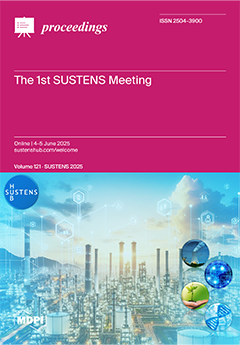Need Help?
Proceedings, 2025, SUSTENS 2025
The 1st SUSTENS Meeting
4–5 June 2025
Volume Editors:
Nikolaos Diangelaki, Technical University of Crete, Greece
Leonidas Matsakas, Luleå University of Technology, Sweden
Gerasimos Lyberatos, National Technical University of Athens, Greece
- Issues are regarded as officially published after their release is announced to the table of contents alert mailing list.
- You may sign up for e-mail alerts to receive table of contents of newly released issues.
- PDF is the official format for papers published in both, html and pdf forms. To view the papers in pdf format, click on the "PDF Full-text" link, and use the free Adobe Reader to open them.
Cover Story (view full-size image):
The 1st SUSTENS Meeting was held virtually on June 4–5, 2025, and was successfully completed with 96 participants. It marked the launch of the SUSTENS Meeting series and the activities of
[...] Read more.
The 1st SUSTENS Meeting was held virtually on June 4–5, 2025, and was successfully completed with 96 participants. It marked the launch of the SUSTENS Meeting series and the activities of SUSTENS HUB—a new international platform that supports sustainable solutions for industry and society by connecting engineers across disciplines and career stages. Topics: (i) Process design, modeling and optimization; (ii) sustainable energy and circularity; (iii) machine learning; (iv) green and innovative chemistries and technologies; (v) biotechnology. The 1st SUSTENS Meeting in numbers: 72 presenters, 58 oral presentations, 14 poster presentations, 7 plenary speakers, 8 invited speakers and 24 attendees and participants from 17 different countries. Three awards were sponsored by SUSTENS HUB to recognize the outstanding work of the authors.
Previous Issue
Next Issue
Issue View Metrics
Multiple requests from the same IP address are counted as one view.



